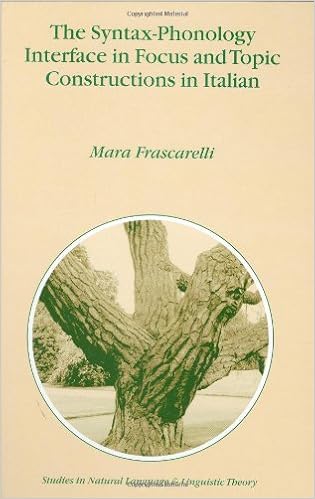
By M. Frascarelli
From the reviews:
"The research of the relevance concentration and subject buildings from either the prosodic and syntactic point of view makes an leading edge contribution to the literature at the interface among syntax and phonology, and, particularly, to the literature on phraseology. additionally, it constitutes an important addition to the research of Italian syntax and phonology."
Pilar Prieto; ICREA and Universitat Autònoma de Barcelona
In: Lingua 115 (2005) 349-352
Read or Download The Syntax-Phonology Interface in Focus and Topic Constructions in Italian PDF
Best italian books
- Della architettura, della pittura e della statua (rist. anast. Bologna, 1782)
- Destini incrociati. Europa e Stati Uniti nel XX secolo
- Marx, istruzioni per l'uso
- Storia delle idee politiche economiche e sociali. L'età della Rivoluzione industriale
Extra resources for The Syntax-Phonology Interface in Focus and Topic Constructions in Italian
Example text
It shows the effects of Focus Restructuring, but this process seems to involve the whole (/J to which it belongs. This amounts to saying that if <1>-domain rules apply between any two elements 38 CHAPTER2 contained within a ci> in broad Focus sentences, these rules will still take place when pre-head constituents are contrastively focused. Sentences (54) below illustrate this point: (54) per TRE panini a. Manger6 three sandwiches for eat- FUT-I SG I will have THREE sandwiches for dinner. cena. dinner giorm m America.
Domain. Consider first of all Prosodic Extraposition (53). On the basis of prosodic phenomena, we argued that what is not included in the Focus is a Topic (cf. 2). Given the SLH, extraposed material must be contained in a prosodic constituent of the same level as the adjacent one. We thus conclude that a Topic must form an I (which is distinct from the sentential I). Let us consider the following sentence in which the Quantifier molte is assigned (contrastive) Focus: (66) Ne ho visitato MOLT£ of-them have- I SG visit-PP many I have visited LOTS of Nordic towns .
At-the end of-the film die-FUT-3SG Carlo At the end of the film Carlo will die. b. Alla fine morira cARLO. non Luigi. At the end CARLO will die, not Luigi. These examples show that Focus Restructuring obligatorily operates on narrow Focus constituents, independently of their syntactic category and the thematic subcategorizations of the verbal Head. On the basis of this evidence, we conclude that Focus Restructuring applies to both kinds of Focus constituents. 19 What our analysis shows is that, as far as prosodic phrasing and (re-)organization are concerned, both kinds of narrow Foci are mapped into a



